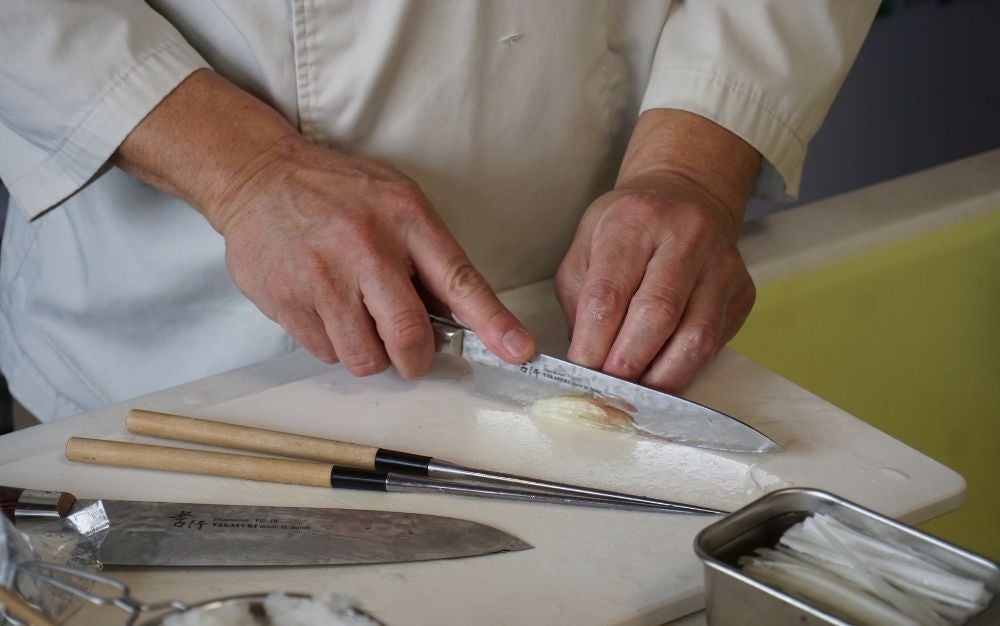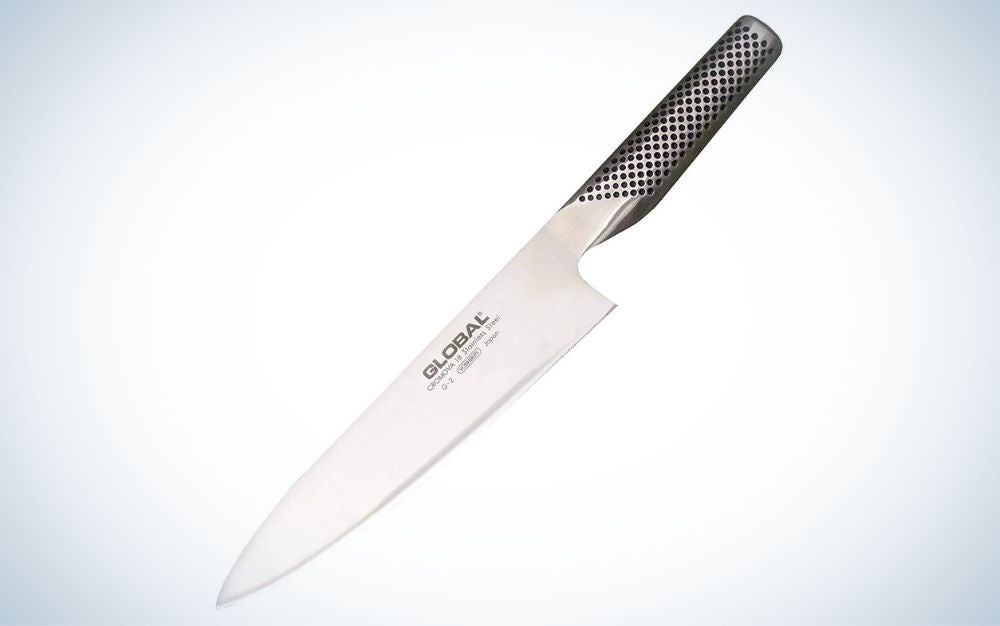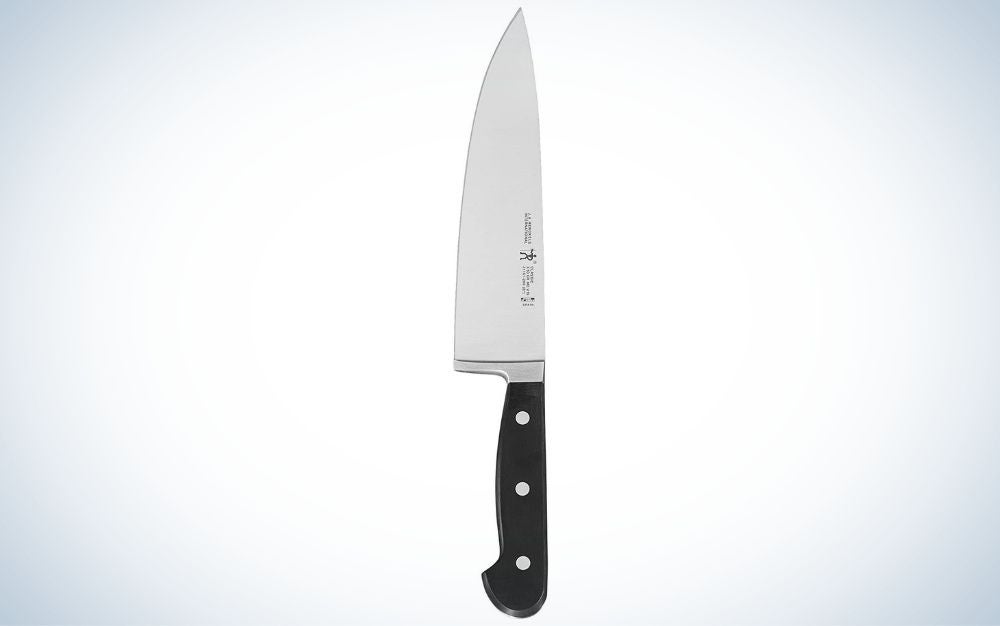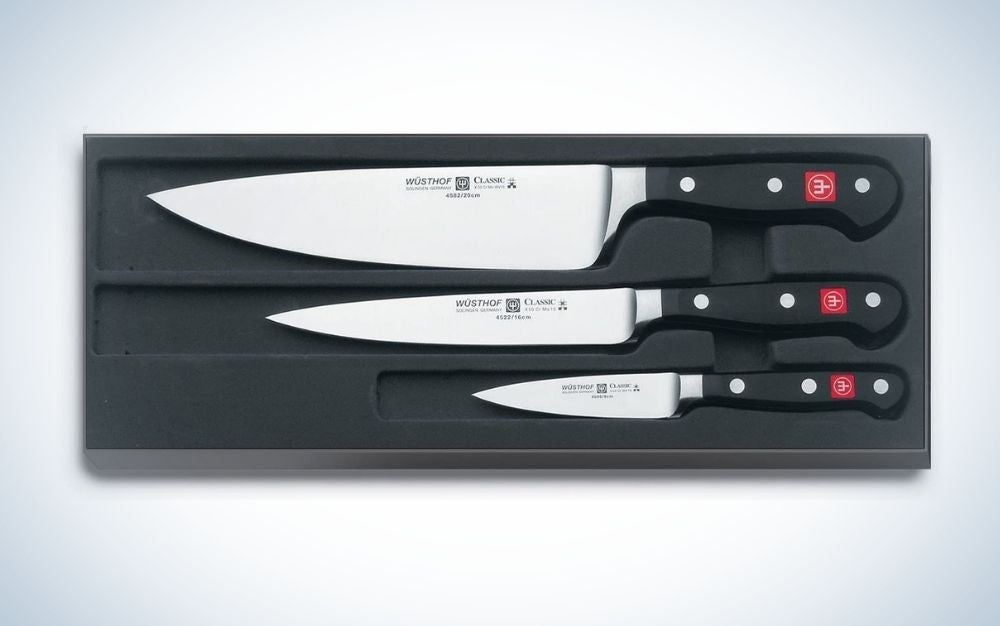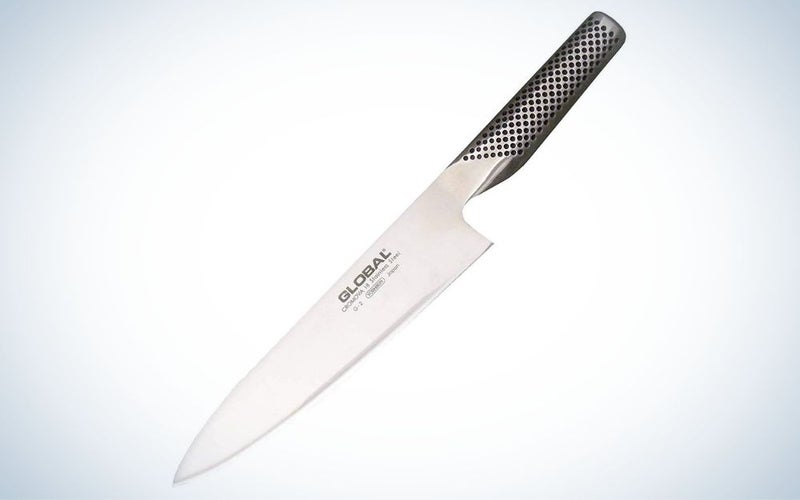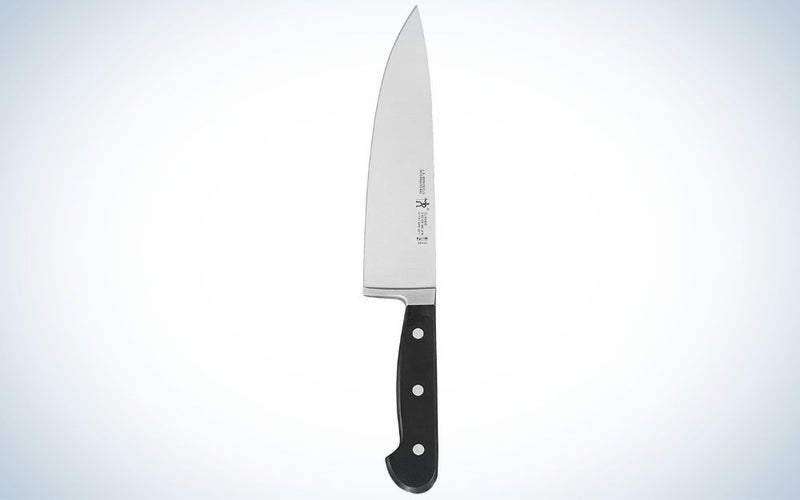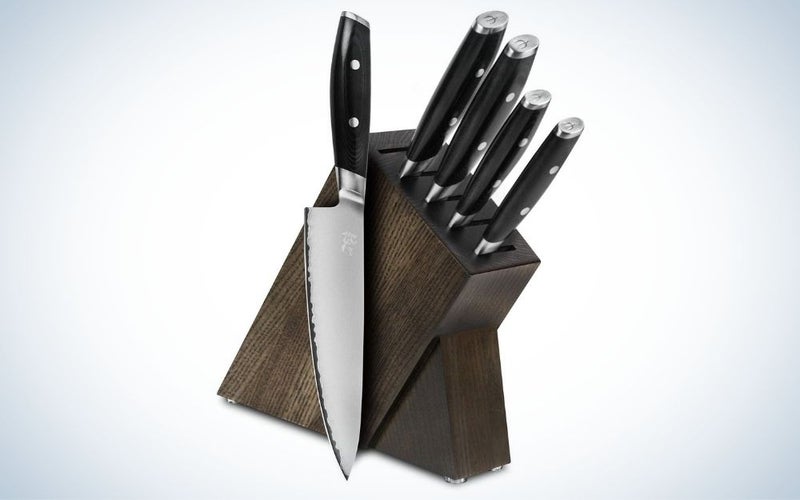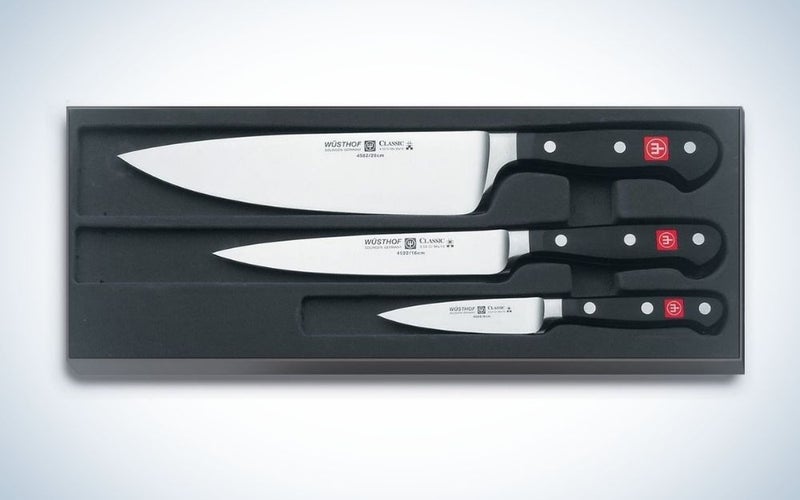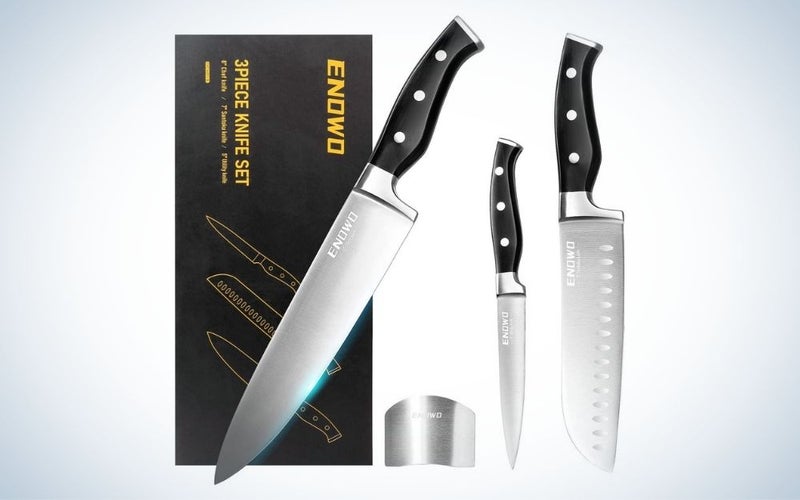We may earn revenue from the products available on this page and participate in affiliate programs. Learn more ›
Whether you’re a pro-level cook or just starting your culinary adventure, knife skills are everything. (Or, at least a lot of the thing.) And the only way to have good knife skills is to have a good knife or knife set. A chef knife—a specific style of knife, not just a knife that chef’s use—is probably what you picture when you picture a sharp knife. It has a curved blade and a distinct point, and it’s super versatile. You can use a chef knife for almost everything, and it’s especially good for rock-chopping (where you keep the tip of the blade stationary on the cutting board and just rock your hand back and forth as you move whatever you are cutting through). Here are our top picks.
- Best overall: Global 8-inch Chef’s Knife
- Best chopping knife: J.A. Henckels International Classic Chef Knife
- Best Japanese knives set: Yaxell Mon 6-piece Knife Set
- Best carbon steel knife: Wüsthof Classic High Carbon Steel 3 Piece Chef’s Knife Set
- Best budget: enowo Chef Knife Ultra Sharp Kitchen Knife Set
What to look for when choosing the best chef knives for you
That’s not a knife—this is a knife! (Please disregard if you happen to be holding a knife while reading this.) The best chef knife isn’t one size fits all, but there are certain key qualities to look out for when you want to buy good kitchen knives.
Should I buy knives individually or as a set?
The benefit to buying a knife set is that you get loads of blade options with one purchase. It feels cost-effective and hassle-free, and you also get a tidy block to store your matching set, so if aesthetics are top of mind, it’s a natural choice. The downside to buying a knife set is that you might end up with knives you don’t need and/or never use. If you’re a new cook, especially, the number of blade options may feel overwhelming. If you stop and think about how many of the knives you’ll be using, then do the math, you might actually be spending more than if you were to buy your knives separately. Another benefit to buying knives separately is that they can just go in the drawer, instead of taking up precious counter space in a block.
What material should I look for in a chef’s knife?
As you start to research chef knives, you’ll likely stumble on two options: carbon steel and stainless steel. Here’s what to know before you decide which one you want: First of all, to make this as confusing as possible, both kinds of steel contain carbon. Carbon steel, you won’t be surprised to learn, just has more. Stainless is harder than carbon; it isn’t as reactive to acids (like in tomatoes and other foods you’ll likely be chopping) and will stand the test of time. Carbon is more sensitive, and therefore prone to rust and corrosion, and it’s typically more expensive. So what’s the benefit of carbon steel knives? They are super sharp and stay that way longer than stainless. Also—though this could be a con for some—they have a break-in period, wherein the knife adapts and molds itself to how you use it. (Pretty cool.) Some of the most famous and chef-loved knives are made of carbon—they’re just a bit more high maintenance. If you keep a pretty meticulous kitchen and can be trusted not to mistreat your knife (forgetting to dry it, dropping it a lot), go for it! If you’re a messy cook (no shame in that game—a lot of us are), your best bet is probably stainless.
What are the top knife brands to look for?
You can’t go wrong with a Wusthof chef knife, a Victorinox chef knife, a Misen, a Kamikoto…. Then there’s MAC, J.A. Henckels, Global, and Mercer. Of course, as with any kitchen appliance (or appliance in general), it all comes down to your personal taste.
Should I buy a full-tang or partial-tang knife?
Reading a knife description can seem like another language if you’re a newbie, and it is—it’s chefs’ language! For example, you’ve likely heard the term “full tang.” If the first thing you think is, “Is that the astronaut drink?” allow us to help you out. The tang is the part of the blade that connects with the handle, so a full-tang blade is one that continues even through the part that you hold, which makes for a more even distribution of weight in your hand. It’s also sturdier, with practically no chance of the blade breaking off from the handle. The blade of a partial-tang knife, on the other hand, only goes part way down the handle, which makes it less evenly weighted but also likely less expensive, since it requires less steel. If you don’t plan to use your knife for anything heavy-duty, a partial-tang style could be perfect for you.
Best chef knives: Reviews & Recommendations
Whether you’re new to cooking or are looking for a versatile tool that you can use for all kinds of recipes, these knives will help you get you chopping in no time.
Best overall: Global 8-inch Chef’s Knife
Global
The Global, which is crafted in Japan, boasts an extra-sharp edge that won’t dull over time. The blade itself is carbon steel and the handle is stainless steel; carbon typically stays sharper longer and is easier to sharpen. On the downside, carbon rusts faster than stainless and is more fragile.
Best chopping knife: J.A. Henckels International Classic Chef Knife
HENCKELS
A forged blade means that the J.A. Henckels International Classic Chef Knife is made from a single bar of steel that is heated and molded into shape. The alternative is stamped, which entails cutting out a blade from a larger sheet of metal. Forged knives tend to be higher quality, heavier, and pricier, but again, it’s all about how it feels in your hand. (Check out PopSci’s tour of the J.A. Henckels factory!)
Best Japanese knives set: Yaxell Mon 6-piece Knife Set
Yaxell
If you’re serious about knives, you can’t go wrong with this set. Crafted with premium Japanese stainless steel, the Yaxell Mon 6-piece Knife Set features five essential knives: a 3.25-inch paring knife, 4.75-inch utility knife, 6.5-inch Santoku knife, 8-inch chef’s Knife, and a 9-inch bread knife that you can store in the included block.
Best carbon steel knife: Wüsthof Classic Carbon-Steel Chef’s Knife Set
Wüsthof
Triple rivets on the handle make this one ergonomic and comfortable to hold. These German knives each have a 16-degree blade angle; different angles are best for different kinds of cutting, and 16 inches straddles hyper-precise Easter knives and more durable Western knives, so you get the best of both worlds.
Best budget: enowo Chef Knife Ultra Sharp Kitchen Knife Set
enowo
The enowo Chef Knife Ultra Sharp Kitchen Knife Set claims to need sharpening only every six months, and the steel resists rust and chipping. Bonus: It comes with a finger guard, to keep you safe while you slice.
FAQs
Q: What knives do chefs prefer?
Ask ten different chefs to name the best knife in the world and you may get ten different answers. According to Men’s Journal, Eric Ripert favors the Japanese-style Mac 8-inch, Daniel Boulud likes the seven-piece Michel BRAS set (which will set you back a cool thousand), and Top Chef’s Michael Voltaggio likes the precision of Houston Edge Works. Meanwhile, Vogue says that Auzerais Bellamy likes the 8-inch by Material, Clare de Boer likes a Santoku over a chef knife—“It beats a German or French chef knife for almost all tasks. I’m not picky about the brand as long as it is sharp,” she says—and Zoe Adjonyoh goes for a Global 8-inch chef knife. Goes to show: Even though you may be looking for the best knife brands, there’s no one right knife. If it feels good to you, that’s your knife!
Q: What is the most important knife in the kitchen?
Though some chefs prefer other more specialized knives (like a Santoku, which is ideal for slicing, dicing, and mincing), most agree that the most important knife in the kitchen is the versatile chef knife. Other than butchering or skinning large veggies, according to Epicurious, an 8- or 10-inch chef knife can do practically everything you need to in the kitchen. It’s a one-stop chop shop.
Q: What is the best knife in the world?
It is impossible to play favorites! But some of the highest-rated knives according to knife reviews by various outlets and Amazon users include the Global 8-inch chef knife, the Mercer 12-inch (which will cost you less than 23 bucks but may also be a little too long for new chefs), and the Victorinox 10-inch.
The final word on shopping for the best chef knives
The best chef knife feels comfortable in your hand and is easy to work with. Whether that means you need something full- or partial-tang, carbon or stainless, eight inches or bigger, individual knives or a set, all comes down to personal preference. You’ll know it when you feel it! Happy slicing and dicing!
